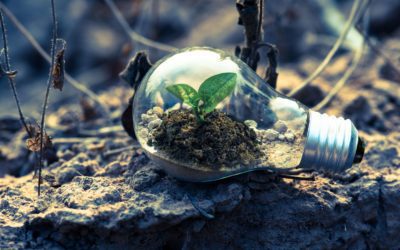How to Compost at Home, and Reduce Your Waste
06
MAY, 2022
By Aileen Richter
Organic waste has a huge negative impact on our environment and could be reduced by 30% through composting. This is more than enough reason to start your own compost container while International Compost Awareness Week is still on. Follow these 4 easy steps to learn how.
What exactly is composting and what benefits does it bring?
Composting is described as the natural process of recycling organic materials, like food scraps and garden waste into a natural fertilizer that can further be used to enrich plants and soil. Composting also creates an ideal environment for organisms that decompose the organic matter, such as worms, bugs and fungi, to thrive. This then speeds up the process. The result is a mass that resembles fertile garden soil. Compost is often called “black gold”, due to the fact that it is rich in nutrients. It can, therefore, be reused as a natural alternative to chemical fertilizers, whether for agricultural use or in your own garden.
To sum it up, composting ensures that less trash ends up in your garbage can. Due to its many benefits, it contributes to the well-being of your plants, and reduces the release of methane into the environment. But how do you start composting? And is it even possible without a garden? The simple answer – yes it is, and we will show you how.

Composting is easier than you think – you can even do it in your own kitchen.
4 easy ways to get started
1. Collect the right organic waste
First of all, you need to collect the right organic waste. Here, a simple rule applies: everything that could attract animals should be kept away from the compost bin. This includes, for example: food cooked in oil or butter, fish, meat or bones.
Furthermore, the secret to a healthy compost pile is the right amount of “Greens” and “Browns”. Greens provide Nitrogen to the compost and include food scraps, green lawn clippings, kitchen waste, and green leaves. Browns add Carbon and include egg shells, coffee grounds, dried leaves or straw. As far as the ratio is concerned, the experts argue that three or four parts browns to one part greens will work. The most important things is that the quantity of browns predominates.

When composting you can use egg shells, vegetable peels or teabags.
2. Choose the right place and compost bin
As said in the beginning, composting is not only for people who have a lot of space available. You can also place a compost bin indoors in any dark and dry place (for example, in the basement or under the sink). A popular way of indoor composting is vermicomposting. Here worms and soil microbes are used to convert waste into a mass consisting of worm droppings and rotted organic material. Plastic storage cans with lids, garbage cans (plastic or metal), or wooden garbage cans are best suited for use as composting containers. In general, 18-gallon bins are a good size for households of two to four people.

You can use plastic or metal garbage cans as composting containers.
3. Prepare your compost bin for vermicomposting
It is important that the compost container is permeable to air. For this purpose, you can simply make holes into the lid and sides of the appropriate container. Also, make sure that you provide good drainage so that excess water can drain out of the container. For a start, you can lay out pieces of newspaper in the container, moisten them with a bit of water, and add a handful of soil on top.
This is when the worms come into play. Eisenia detid, or Red Wigglers are best suited for your vermicomposting bin. Better not try to use the earthworms you find in your garden though, as they would only die in your compost bin. This is due to the fact that the bin does not provide an optimal habitat for them to survive. As for the amount of worms, worm farming experts recommend a 1:1 ratio. So one pound of worms (the equivalent of about 1,000 worms) to one pound of garbage added daily, works well.

Be sure to use Red Wigglers for your compost can.
4. Add your food scraps, wait and harvest
For quick composting, make sure to cut the food scraps into small pieces, which you can then bury in the bedding. This step allows the worms to do their work faster. A great advantage of vermicomposting is that it is not necessary to turn the compost by hand. This is because the worms naturally aerate the compost as they churn through it.
To harvest the finished compost, separate the fully composted waste from the partially composted waste, by moving them to opposite sides of the bin. You can also place the partially composted food in the center, where more food waste can then be added on top. The worms will take about 2 weeks to move to the partially composted waste pile with the new food, to continue composting. In about three to four months, you can harvest and use the finished compost. If you can’t find a use for it, give it to your local community garden.

Your compost will be ready to harvest after 3 – 4 months.
As you can see, composting is not as complicated as it seems at first glance, and is surprisingly easy to implement even in the tightest of spaces. So with a little effort and confidence, you can soon harvest your own compost and make a contribution to environmental protection! Happy composting!
The connection between sustainability and permaculture
The connection between sustainability and permaculture 24 SEPTEMBER, 2018 By Pierre In what can be described as a period of reawakening regarding environmental consciousness, it is important to make people aware of best practice in minimising our impact. Both...
Eco-Friendly Vehicle – How to Turn your Car into one
How to Turn your Car into an Eco-Friendly Vehicle 24 OCTOBER, 2018 By Mattea Jacobs One of the most significant contributors to harmful greenhouse gasses is transportation due to the burning of fossil fuels. Nowadays, innovative inventions like the hybrid car and the...
How To Live Off-The-Grid: Easy Steps You Can Follow
How to live off-the-grid:Easy Steps You Can Follow 3 AUGUST, 2018 By Abdul Rahman Mahayni In a world dominated by consumerism and the achievement of wealth, many have taken it upon themselves to adopt a lifestyle in which they’re wholly responsible for themselves. As...
Greenpop Foundation NPC is a registered non-profit organisation. Registration Number (NPO): 151-411 NPO.


